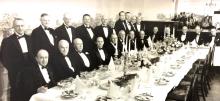The Walpole Society, a small, all-male, and very exclusive group of collectors and scholars of Americana, was founded in 1910. From the beginning the men decided their purpose was to share knowledge and enjoy one another’s company while visiting private and public collections together. And they have continued to do that, publishing since 1926 in their annual Note Book the record of their journeys. The Note Book also serves as a place where members publish essays and articles on topics of mutual interest, i.e., specific objects, collections of objects, or on collecting or connoisseurship in general.
The Walpoleans have no headquarters, no real estate at all. Just thirty in number at any one time — a member has to die before another is elected — the brethren, as they call themselves, come together a few times a year and then go on their separate ways. Hence, their need for repositories for their Note Book. In 1931, a motion “to deposit [them] in the American Antiquarian Society, at Worcester” was not carried at an executive meeting of the Walpoleans. The reason: the group’s “fear that invidious comparisons might be drawn as to why one institution was favored over another.” Ten years later, however, the men overcame that fear, and AAS was designated the sole depository to receive all publications of the group. More recently, four other institutions— the Wintherthur Museum, Garden & Library in Wilmington, Delaware; the New-York Historical Society in Manhattan; the Library Company of Philadelphia; and the University of Virginia in Charlottesville—were given the same status.
If I expected to write comprehensively about the Wapoleans, I knew that at the least I needed to sit down and read their Note Book’s full run. The AAS is an hour’s drive from my house in Andover, Massachusetts, and conceivably I could have done the reading piecemeal over a period of time. What the fellowship allowed me to do was to sit and read the volumes straight through, which was a far, far more effective way to see and feel the whole sweep of the club’s history.
The reading of the Note Book, along with other books published by the Walpole Society — e.g., volumes issued on the occasions of their 50th and 75th anniversaries — was the main objective of my fellowship month, and I completed it. It took nearly three weeks. In the remaining time I read books by Walpoleans, books about them, and books about their collections. As an independent writer without access to a university library, I found it exhilarating to browse through the computer catalog and find what I was looking for. Having the desire for a particular book and then having it appear ten minutes later on my desk is quite an experience for someone unaccustomed to it. An uninterrupted thought process is a rare luxury that this fellowship afforded me.
I also read manuscript collections of letters written by and to various members, including Thomas W. Streeter; Lawrence Wroth; George Parker Winship; William B. Goodwin; and the AAS’s own Clarence Brigham. The Brigham letters were from the AAS Archives. These letters are so plentiful because of the close association between individual Walpoleans and AAS. Indeed, more than half of all 145 or so Walpoleans have also been AAS members.
The archives of the Walpole Society itself is at Winterthur and I made several trips there in order to look through the official correspondence, but the letters at AAS were often more illuminating, because they were about things other than straightforward Walpolean business. That is, in the Winterthur letters the men are most often discussing the bread and butter of the organizational matters of their group. In the AAS letters, by contrast, they are often discussing their life’s passion: their collections.
The five-part series was previously published in the Maine Antique Digest.
- Good Fellows: The Walpole Society
- Good Fellows: The Walpole Society
- Good Fellows: The Walpole Society
- Good Fellows: The Walpole Society
- Good Fellows: The Walpole Society

